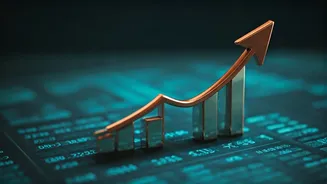Market Dynamics Unveiled
Copper, often viewed as an economic bellwether, has been experiencing a period of price adjustments. This situation is largely due to the intricate interplay
between international trade tensions and the financial state of China, a major player in the copper market. Investors constantly analyze the implications of trade conflicts, which can disrupt supply chains and impact demand. Simultaneously, China's economic growth rate, manufacturing activity, and overall economic performance significantly influence copper consumption. Therefore, fluctuations in these areas directly affect copper prices, compelling investors to monitor these aspects closely. The ongoing trade disputes, involving tariffs and other trade barriers, create uncertainties that influence market sentiment, frequently leading to volatility. China's economic expansion or contraction also impacts copper demand due to its widespread use in infrastructure development and industrial manufacturing. These elements, combined with other global events, paint a comprehensive picture of the factors driving copper price movements. The investment community continuously assesses these elements, adjusting their strategies in response to shifts in the economic landscape and geopolitical events that impact this essential industrial metal.
Trade Tensions Impact
The existence of trade tensions between major economic powers plays a significant role in influencing copper prices. Any kind of tariff implementations or trade restrictions can have a direct impact on the import and export dynamics of copper, subsequently leading to changes in supply and demand. If tariffs are imposed on copper imports, the cost of the metal increases, potentially diminishing the demand, which may cause prices to fall. Conversely, if export restrictions are implemented in major copper-producing nations, supply diminishes, which may then push prices upward. Furthermore, uncertainties concerning trade agreements create instability in the market, making it challenging for investors to predict future price movements accurately. The uncertainty resulting from trade disputes discourages long-term investments, which can also influence the volatility of copper prices. Investors, therefore, remain vigilant of trade developments, monitoring news and assessing its possible impacts on the global copper market and adjusting their strategies accordingly. These assessments encompass studying trade negotiations, policy decisions, and the economic reactions of the countries involved, ensuring investors are able to make well-informed decisions.
China's Economic Outlook
The economic conditions in China are of great importance to the copper market because China is the world's largest consumer of copper. China's economic growth, particularly in sectors such as infrastructure development, construction, and manufacturing, significantly drives the demand for copper. A strong economic performance accompanied by increased industrial activities usually supports higher copper prices. Conversely, any economic slowdown or reduced manufacturing output in China can weaken demand, causing copper prices to fall. Investors keenly watch indicators such as the Purchasing Managers' Index (PMI) for manufacturing, construction activity levels, and government infrastructure spending plans. These economic barometers help to forecast future demand for copper. Moreover, any policy decisions made by the Chinese government, especially those that aim to stimulate economic activities or implement environmental regulations, also hold great significance. These factors collectively influence investor sentiments and, in turn, directly affect copper prices. As a result, China's economic outlook remains a key factor that investors closely analyze when evaluating the copper market, making their decisions based on thorough analysis and anticipation of potential impacts on supply and demand.
Investor Sentiment Analysis
The attitudes and perspectives of investors significantly shape the behavior of copper prices. Investor sentiment, which is a reflection of overall optimism or pessimism about the market, is driven by various factors. These can include assessments of global economic growth, trade relations, China’s economic health, and any geopolitical events. Positive investor sentiment typically leads to greater demand for copper as investors seek to capitalize on rising prices, while pessimistic views frequently cause a sell-off, subsequently lowering prices. The availability of economic data and company earnings reports plays a crucial role in forming investor sentiments. Strong economic data and positive corporate performance, like robust manufacturing output numbers, often lift investor confidence, while any adverse indicators can trigger worry. News about policy changes or unexpected geopolitical events also affects investor outlook, prompting rapid adjustments in trading strategies. Furthermore, any analysis of market trends, technical indicators, and expert forecasts play a critical role in informing investor decisions. A thorough understanding of the factors that shape investor sentiment is crucial for comprehending the dynamics behind copper price movements.
Future Market Projections
Forecasting the future of copper prices involves analyzing several key economic, political, and market-related variables. The forecast is based on an in-depth understanding of the global economy, the status of trade relations, and the economic conditions of major copper consumers like China. The predictions consider several aspects, including the projected global economic growth, infrastructure investments, and industrial production rates. Additionally, the forecasts consider the expected developments in international trade, such as the resolution or escalation of trade disputes, and any impacts on import and export policies. Moreover, expert views, industry analyses, and market sentiment also play a vital role. Any insights into these areas from financial institutions, market analysts, and industry specialists can provide clues regarding the future direction of copper prices. For instance, strong worldwide economic growth, coupled with increased infrastructure investment, could boost demand and push prices higher, while any trade uncertainties or a slowdown in industrial output could create downward pressure on prices. Due to the inherent uncertainty of global economic and political situations, predicting the future of copper prices involves an ongoing assessment, along with adjusting the strategies accordingly.



















